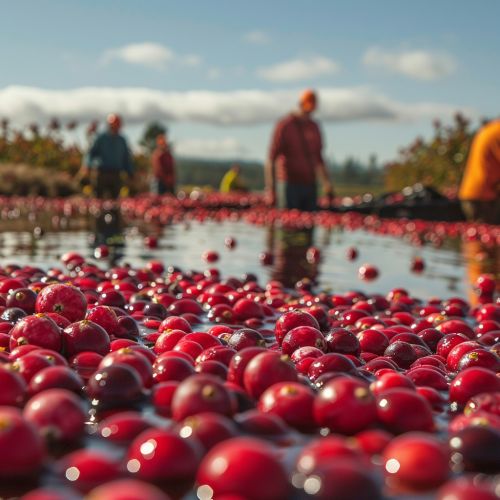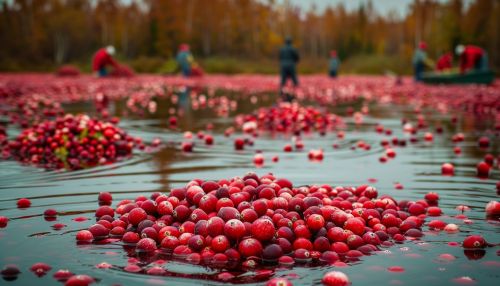Cranberries
Introduction
Cranberries are a group of evergreen dwarf shrubs or trailing vines in the subgenus Oxycoccus of the genus Vaccinium. They are native to North America, particularly in the northeastern and north-central regions, including parts of Canada. Cranberries are known for their tart flavor and are commonly used in sauces, juices, and as a dried fruit. This article delves into the botanical characteristics, cultivation, nutritional profile, and various uses of cranberries, providing a comprehensive overview for those interested in this unique fruit.


Botanical Characteristics
Cranberries belong to the family Ericaceae, which also includes blueberries and huckleberries. The most common species are Vaccinium macrocarpon (American cranberry) and Vaccinium oxycoccos (European cranberry).
Morphology
Cranberry plants have slender, wiry stems that are not thickly woody and can grow up to 2 meters long. The leaves are small, evergreen, and oval-shaped, with a dark green color on the upper side and a lighter, whitish-green underside. The flowers are dark pink, with distinctive reflexed petals that leave the style and stamens fully exposed, resembling a crane's head and bill, which is how they got their name.
Reproduction
Cranberries reproduce through both sexual and asexual means. Sexual reproduction occurs via pollination, primarily by bees, leading to the development of berries. Asexual reproduction happens through the plant's ability to produce runners, or stolons, which spread across the ground and root at intervals to form new plants.
Cultivation
Cranberries require specific conditions for optimal growth, including acidic peat soil, adequate fresh water, and a growing season that extends from April to November.
Soil and Climate Requirements
Cranberries thrive in acidic soils with a pH range of 4.0 to 5.5. They are typically grown in bogs or marshes that have been modified to provide the necessary conditions. These bogs are often layered with sand, peat, gravel, and clay to create the ideal growing environment. The climate should provide a cold winter period for dormancy and a frost-free growing season.
Planting and Maintenance
Cranberry beds are usually established by planting cuttings from existing vines. These cuttings are spread over the prepared bed and pressed into the soil. Maintenance includes regular sanding, which involves spreading a thin layer of sand over the vines to stimulate new growth and control pests and diseases. Water management is crucial, as cranberries require a consistent supply of fresh water, especially during the growing season and harvest.
Harvesting
Cranberries are harvested in the fall when they turn a deep red color. There are two primary methods of harvesting: dry and wet. Dry harvesting involves using mechanical pickers to comb the berries off the vines. Wet harvesting involves flooding the bogs with water, causing the berries to float to the surface, where they are then corralled and collected.
Nutritional Profile
Cranberries are rich in various nutrients and bioactive compounds, making them a valuable addition to a healthy diet.
Macronutrients
A 100-gram serving of raw cranberries provides approximately 46 calories, with 0.1 grams of fat, 12.2 grams of carbohydrates, and 0.4 grams of protein. They are also a good source of dietary fiber, with about 4.6 grams per serving.
Micronutrients
Cranberries are rich in vitamins and minerals, including vitamin C, vitamin E, vitamin K1, manganese, and copper. They also contain various phytonutrients, such as flavonoids and phenolic acids, which contribute to their antioxidant properties.
Health Benefits
Cranberries are known for their potential health benefits, particularly in preventing urinary tract infections (UTIs). They contain proanthocyanidins, which can inhibit the adhesion of certain bacteria to the urinary tract walls. Additionally, the antioxidants in cranberries may help reduce the risk of chronic diseases, such as cardiovascular disease and certain cancers.
Uses of Cranberries
Cranberries are versatile and used in various culinary and non-culinary applications.
Culinary Uses
Cranberries are commonly used in sauces, juices, and baked goods. Cranberry sauce is a traditional accompaniment to turkey during Thanksgiving in the United States. Dried cranberries are popular in trail mixes, salads, and baked goods. Cranberry juice is often consumed for its potential health benefits and tart flavor.
Industrial Uses
Beyond culinary applications, cranberries are used in the production of dyes and cosmetics. The pigments in cranberries can be extracted and used as natural colorants in various products.
Medicinal Uses
Cranberries have a long history of use in traditional medicine. Native Americans used cranberries to treat wounds and as a food preservative. Modern research supports some of these uses, particularly the role of cranberries in preventing UTIs and their antioxidant properties.
